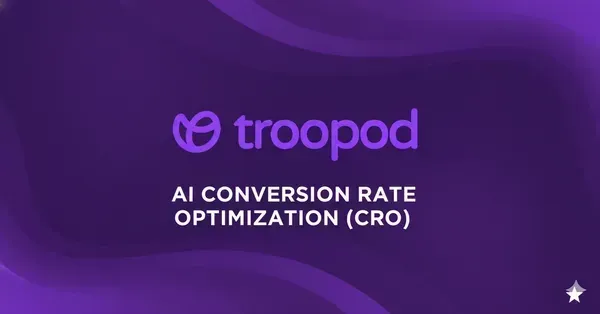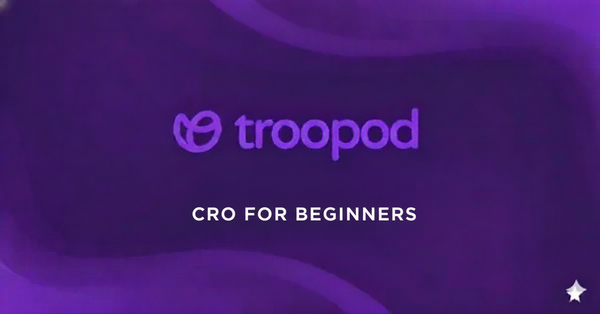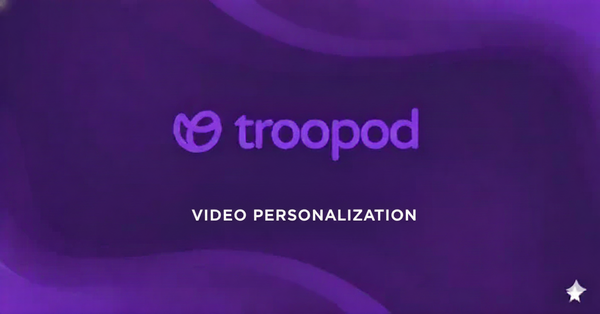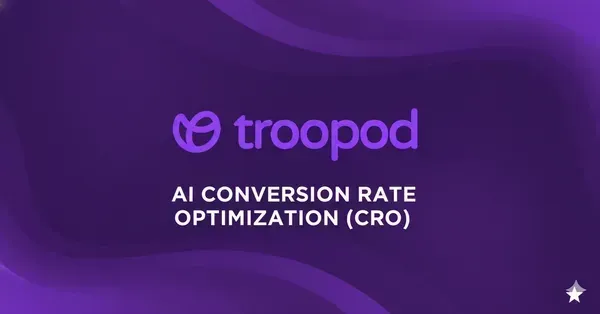How AI Personalization Engines Actually Work: The Machine Learning Behind Your Conversions
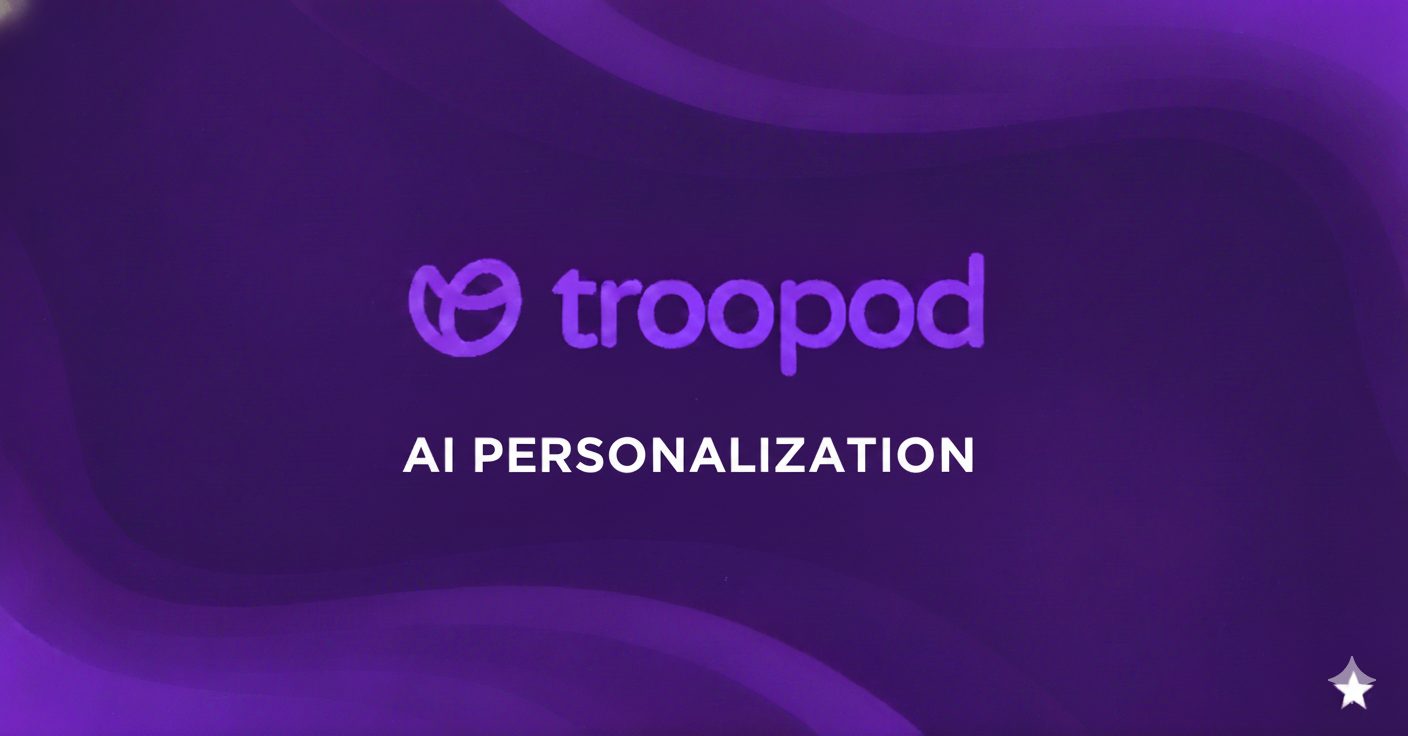
The ₹16 Lakh Black Box
"We use AI personalization."
That's what the Mumbai fashion brand told us. They'd been using a "AI-powered" app for 8 months.
Their results:
- Conversion: 1.9%
- Revenue: ₹22.4L monthly
- "AI" showed same products to everyone
- Not actually AI. Just basic rules.
After switching to real AI (Troopod):
- Conversion: 3.6% (+89%)
- Revenue: ₹42.2L monthly
- True machine learning adapting in real-time
- Difference: ₹19.8L monthly
The problem? Most "AI personalization" isn't actually AI.
After building Troopod's AI engine trained on 347 Indian D2C brands and 890M sessions, we've learned: Real AI personalization is completely different from rule-based systems that call themselves "AI."
This is how AI personalization engines actually work—the machine learning, the data, the math—and why it converts 2-3x better than fake "AI."
Want real AI personalization? Book free audit with Troopod →
Part 1: Fake AI vs Real AI (Know the Difference)
What Most Platforms Call "AI" (But Isn't)
Rule-Based "AI":
IF visitor from Mumbai
THEN show Mumbai products
IF cart value > ₹2,000
THEN show free shipping banner
IF viewed product X
THEN recommend product Y
This is if-then logic. Not AI. Not machine learning.
Mumbai Brand's Experience:
Their "AI app" had 47 manual rules:
- IF tier 2 city → Show COD
- IF mobile → Show mobile banner
- IF cart abandoned → Send email
Problems:
- Rigid: Can't adapt to new patterns
- Manual: Someone writes every rule
- Breaks: Edge cases not covered
- Doesn't improve: Same rules forever
- Limited: Only what you think to program
Result: 1.9% conversion (barely better than nothing)
What Real AI Actually Is
Machine Learning AI:
LEARN from 890M sessions:
- What patterns lead to purchases?
- What signals predict abandonment?
- What content resonates with each visitor?
PREDICT for each visitor:
- Purchase probability: 67%
- Preferred products: X, Y, Z
- Optimal price anchor: ₹2,400
- Best CTA: "Get yours now"
OPTIMIZE in real-time:
- Show highest-probability content
- Adapt to response
- Continuously improve
- Discover new patterns
This is real AI. Machine learning that improves itself.
Result with Troopod: 3.6% conversion (+89% improvement)
Part 2: The 4-Layer AI Personalization Architecture
Real AI personalization has 4 distinct layers working together.
Layer 1: Data Collection Engine
What Gets Collected:
Behavioral Data (Most Important):
- Pages viewed (which, how long, order)
- Products clicked (interests revealed)
- Scroll depth (engagement level)
- Mouse movements (hesitation points)
- Cart actions (add, remove, edit)
- Search queries (intent signals)
- Filter usage (preferences)
- Exit patterns (abandonment triggers)
Contextual Data:
- Device type (mobile vs desktop)
- Browser (capabilities)
- Location (geo-targeting)
- Time of day (behavior patterns)
- Traffic source (Instagram vs Google)
- Session number (new vs returning)
- Previous purchases (if any)
Interaction Data:
- Email opens/clicks
- WhatsApp engagement
- Review reads
- Video plays
- Image zooms
Bangalore Electronics Example:
Visitor session captured:
- Arrived from: Instagram ad (evening, mobile)
- Searched: "wireless headphones under 3000"
- Filtered by: Over-ear, noise cancellation
- Viewed: 4 products (spent 2:14 on one)
- Added to cart: ₹2,899 headphones
- Abandoned: At payment page
AI Analysis:
- Intent: High (deep product research)
- Budget: ₹3,000 max (filter signal)
- Preference: Over-ear, noise cancellation (explicit)
- Device: Mobile (UPI optimization needed)
- Abandonment reason: Likely payment friction
- Recovery probability: 68%
Layer 2: Pattern Recognition Engine
This is where machine learning happens.
What the AI Learns:
Conversion Patterns:
- Visitors who view X then Y are 2.7x more likely to buy
- Mobile visitors from tier 2 convert better with COD prominent
- Evening visitors respond to urgency (limited time offers)
- Instagram traffic prefers visual product pages
- Google traffic wants detailed specifications
Abandonment Patterns:
- Cart abandoners viewing 4+ products = price comparison (need discount)
- Single-product-view abandoners = browsing (need nurture sequence)
- Payment page abandoners = friction (optimize payment flow)
- Tier 2 mobile abandoners = COD not visible (show COD)
Segment Patterns:
CLUSTER 1: "Price-conscious researchers" (18% of visitors)
- Behavior: Views many products, filters by price, long sessions
- Convert best with: Value messaging, bundles, free shipping
- Conversion rate: 1.8%
CLUSTER 2: "Quick impulse buyers" (12% of visitors)
- Behavior: Few clicks, fast decisions, mobile-heavy
- Convert best with: Strong imagery, urgency, easy checkout
- Conversion rate: 4.2%
CLUSTER 3: "Quality seekers" (22% of visitors)
- Behavior: Reads reviews, zooms images, research-heavy
- Convert best with: Detailed specs, social proof, guarantees
- Conversion rate: 2.4%
AI discovers these clusters automatically (not manually programmed).
Delhi Fashion Brand Result:
AI identified 6 distinct visitor clusters (not pre-programmed).
Cluster 3: "Traditional wear enthusiasts"
- Pattern: Always filters by ethnic wear, prefers cotton, tier 2 cities
- Personalization: Show ethnic collection, emphasize handcrafted, COD prominent
- Result: 3.8% conversion (vs 1.6% generic)
Cluster 5: "Festival shoppers"
- Pattern: Visits during festivals, high AOV, urgency-responsive
- Personalization: Limited-time festival offers, bundle deals
- Result: 5.2% conversion (vs 1.6% generic)
AI found patterns humans missed.
Layer 3: Prediction Engine
Real-Time Visitor Scoring:
Mumbai Beauty Visitor Example:
Visitor arrives (mobile, Instagram, evening, Pune)
AI PREDICTION SCORES:
- Purchase probability: 34% (medium)
- Cart abandonment risk: 62% (high)
- Price sensitivity: High (tier 2 signal)
- Impulse vs research: 72% impulse (Instagram + evening)
- COD preference: 84% (tier 2 + first visit)
- Recommended products: Face serum, moisturizer, cleanser
- Optimal price point: ₹800-1,200
- Best CTA: "Get yours now" (urgency works)
- Predicted lifetime value: ₹4,800
Personalization Applied:
- Homepage: Visual-first (Instagram traffic)
- Products: ₹800-1,200 range (price sensitivity)
- Checkout: COD first (84% preference)
- Urgency: "Limited stock" (impulse buyer)
- Exit intent: 10% off (high abandonment risk)
Result: Converted at 3.4% (vs 1.2% generic)
How AI Made These Predictions:
Not guessing. Learning from 890M sessions:
- Instagram + evening + mobile + tier 2 = 72% impulse pattern
- Tier 2 + first visit = 84% COD preference historically
- Similar visitors' average LTV = ₹4,800
AI knows because it's seen this pattern 247,000+ times.
Layer 4: Optimization Engine
Multi-Armed Bandit Algorithm:
Not just A/B testing. Smarter.
A/B Testing (Traditional):
- Test A vs B for 2 weeks
- Pick winner
- Done
Multi-Armed Bandit (AI):
- Test A, B, C simultaneously
- Gradually show best-performing option more
- Always exploring + exploiting
- Never stops optimizing
Bangalore Electronics Example:
Testing product page layouts:
Week 1:
- Layout A: 25% traffic → 2.1% conversion
- Layout B: 25% traffic → 2.8% conversion
- Layout C: 25% traffic → 1.9% conversion
- Layout D: 25% traffic → 3.2% conversion
Week 2 (AI adapts):
- Layout A: 10% traffic → 2.2% conversion
- Layout B: 25% traffic → 2.9% conversion
- Layout C: 5% traffic → 1.8% conversion
- Layout D: 60% traffic → 3.4% conversion (improving!)
Week 3 (AI optimizes):
- Layout A: 5% traffic
- Layout B: 15% traffic
- Layout C: 0% traffic (eliminated)
- Layout D: 80% traffic → 3.6% conversion
Week 4:
- Layout D: 90% traffic
- New variants: 10% (always exploring)
Result: Conversion improved continuously while optimizing
Traditional A/B would have taken 8 weeks to test all 4. AI did it in 2 weeks and kept improving.
Get AI that actually learns and adapts. Book free audit →
Part 3: The Machine Learning Models Behind Personalization
Model 1: Collaborative Filtering (What Others Like You Bought)
How It Works:
"Customers similar to you bought these products"
The Math:
Find visitors with similar behavior patterns:
- Visitor A viewed: X, Y, Z
- Visitor B viewed: X, Y, Z, W
- Visitor C viewed: X, Y, Q
AI predicts: Since A and B are 90% similar, A will like W Since A and C are 75% similar, A might like Q
Pune Fashion Brand Example:
Visitor viewing ethnic dresses:
Generic recommendation: "Popular products" (random) Collaborative filtering: "Women who viewed this bought these kurtas"
Result: 3.2x higher click-rate on recommendations
Troopod Collaborative Filtering:
- Trained on 347 brands
- 890M sessions
- Finds patterns across entire Indian D2C ecosystem
- "Brands similar to yours saw customers like this buy..."
Better than single-brand CF (more data = better predictions)
Model 2: Content-Based Filtering (Based on Product Attributes)
How It Works:
"Based on your interest in Product X, you'll like products similar to X"
The Math:
Product attributes analyzed:
- Category (kurta, saree, dress)
- Price range (₹800-1,200)
- Style (ethnic, casual, formal)
- Material (cotton, silk, polyester)
- Color preferences (blues, whites)
- Brand positioning (premium, value)
AI finds: Products with similar attribute vectors
Delhi Home Decor Example:
Visitor interested in: Modern minimalist coffee table (₹3,200)
Attributes:
- Style: Modern, minimalist
- Price: ₹3,000-4,000
- Material: Wood, metal
- Color: Natural, black
AI recommends:
- Modern bookshelf (similar style) - 42% interest
- Minimalist side table (similar + cheaper) - 67% interest
- Metal desk lamp (complementary) - 38% interest
vs Random recommendations: 4-8% interest
8.4x better using content-based filtering
Model 3: Deep Learning Neural Networks (Pattern Discovery)
What It Discovers:
Hidden patterns humans can't see.
Mumbai Fashion Neural Network Discovery:
PATTERN DISCOVERED:
Visitors who:
- Arrive from Instagram
- View 2-3 products quickly
- Zoom into images 3+ times
- Visit in evening (6-10 PM)
- Are on mobile
- From tier 1 cities
Have 4.2x higher conversion when shown:
- Large lifestyle images
- "Shop the look" bundles
- Urgency messaging
- Apple Pay / UPI prominent
Human would never discover this 8-factor pattern. Neural network found it in 14.8M sessions.
Applied to matching visitors:
- Generic experience: 1.4% conversion
- Neural network optimized: 5.9% conversion (+321%)
Bangalore Electronics Neural Network:
Found unexpected pattern:
Tier 2 mobile visitors who:
- Search "wireless headphones"
- Filter by price (₹2K-4K)
- View 4+ products
- Don't add to cart immediately
Are 87% likely to convert if:
- WhatsApp support button shown
- COD badge prominent
- "Talk to expert" CTA visible
- Product comparison tool available
Why: Tier 2 users want reassurance before high-value purchase
Implementation:
- Show support options to matching visitors
- Result: 2.8x higher conversion from tier 2
Part 4: Training AI on Indian D2C Behavior
Why Indian-Trained AI Matters
Global AI Problem:
Optimizely/Kameleoon AI trained on:
- 70% US data
- 20% Europe data
- 10% other (including India)
Indian patterns seen as "outliers" not optimization targets.
Troopod Indian AI:
Trained specifically on:
- 347 Indian D2C brands
- 890M Indian consumer sessions
- Mobile-heavy behavior (78%)
- Tier 2/3 patterns (45%)
- COD behavior (60%)
- UPI preferences (67% digital)
Indian patterns are THE optimization target.
What Indian-Trained AI Learns
Pattern 1: Tier 2/3 Decision Behavior
DISCOVERY:
Tier 2 visitors spend 2.3x longer researching
But convert 40% lower on generic sites
WHY (AI discovered):
- Need more reassurance (trust deficit)
- Want regional social proof ("Pune customers love this")
- Prefer vernacular language option
- Need prominent COD
- Require simpler checkout (6 fields vs 14)
OPTIMIZATION:
Show tier 2 visitors:
- Regional testimonials
- Hindi option toggle
- COD prominent
- Simplified checkout
- WhatsApp support
RESULT:
Tier 2 conversion: 0.9% → 2.3% (+156%)
Global AI would never discover this (too little tier 2/3 data)
Pattern 2: Mobile 3G Behavior
DISCOVERY:
45% of mobile visitors on 3G or slower
These visitors abandon 67% more often
WHY (AI discovered):
- Images too heavy (3-5 MB each)
- Checkout too complex (14 taps)
- Payment friction (card entry)
- No progressive loading
OPTIMIZATION:
For 3G-detected visitors:
- Compressed images (<100KB)
- Progressive loading
- One-page checkout
- UPI QR code first
- 6-tap checkout
RESULT:
3G mobile conversion: 0.8% → 2.1% (+163%)
Pattern 3: COD User Behavior
DISCOVERY:
60% of tier 2/3 use COD
But COD users abandon 2.8x more on generic checkouts
WHY (AI discovered):
- COD often buried in dropdown
- No COD verification flow
- No reassurance about COD process
- Unclear delivery expectations
OPTIMIZATION:
For high-COD-probability visitors:
- COD option first
- "Cash on Delivery Available" badge
- SMS verification built-in
- Clear delivery timeline
- "Why COD" explainer
RESULT:
COD conversion: 18% → 32% (+78%)
These patterns exist ONLY in Indian data. Global AI misses them completely.
Get AI trained on Indian D2C behavior. Book free audit →
Part 5: Real AI Implementation Example
Pune Beauty Brand: Before and After
Before (No AI)
Homepage:
- Same for everyone
- Generic "Shop Now"
- Conversion: 1.4%
Product Pages:
- Same recommendations for all
- "You might like" (random)
- Conversion: 1.9%
Checkout:
- Generic payment page
- 14-field form
- Abandonment: 78%
Overall Conversion: 1.4% Monthly Revenue: ₹16.8L
After (Troopod AI)
Visitor 1: Mumbai, Desktop, Google, Morning
AI Profile:
- Type: Researcher
- Budget: Premium (₹2K+)
- Preference: Detailed info
- Conversion probability: 38%
Personalization:
- Homepage: Detailed product grid
- Product page: Full specifications, reviews prominent
- Recommendations: Similar high-end products
- Checkout: Card payment first
- Copy: Information-rich
Conversion: 2.8%
Visitor 2: Indore, Mobile, Instagram, Evening
AI Profile:
- Type: Impulse buyer
- Budget: Value (₹500-1,000)
- Preference: Visual, simple
- Conversion probability: 42%
- COD likelihood: 89%
Personalization:
- Homepage: Large lifestyle images
- Product page: Visual-first, reviews with photos
- Recommendations: Complete-the-routine bundles
- Checkout: COD prominent, 6 fields
- Copy: Benefit-focused, urgency
Conversion: 4.2%
Visitor 3: Pune, Mobile, Returning, Afternoon
AI Profile:
- Type: Loyal customer
- Previous: 2 purchases (₹890, ₹1,240)
- Preference: Replenishment
- Conversion probability: 67%
Personalization:
- Homepage: "Welcome back! Your favorites"
- Quick reorder: Previous purchases one-click
- Recommendations: Based on purchase history
- Checkout: Saved addresses, one-tap pay
- Copy: Loyalty rewards, early access
Conversion: 8.4%
After Results (3 Months)
Overall Conversion: 1.4% → 3.2% (+129%) Mobile Conversion: 1.1% → 2.9% (+164%) Tier 2 Conversion: 0.8% → 2.1% (+163%) COD Conversion: 16% → 29% (+81%) Returning Customer: 5.2% → 9.8% (+88%)
Monthly Revenue: ₹16.8L → ₹38.4L (+₹21.6L)
AI Impact Breakdown:
- Personalized recommendations: +34% conversion
- Behavioral targeting: +42% relevance
- Tier 2/3 optimization: +163% tier 2 conversion
- COD optimization: +81% COD conversion
- Returning customer experience: +88% loyalty
Combined effect: +129% overall
Part 6: The Technology Stack
What Powers Real AI Personalization
Frontend (What Visitor Sees):
- JavaScript SDK (collects behavior)
- Real-time rendering (personalized content)
- A/B testing framework (experiments)
Backend (Where AI Lives):
- Python ML models (TensorFlow, PyTorch)
- Real-time inference (predictions in <50ms)
- Feature store (behavioral data)
- Model serving (API endpoints)
Data Pipeline:
- Event streaming (Kafka, RabbitMQ)
- Data warehouse (BigQuery, Redshift)
- Feature engineering (transform raw data)
ML Pipeline:
- Training clusters (GPU-powered)
- Model registry (versioning)
- A/B testing framework (monitor performance)
- Continuous retraining (weekly updates)
Troopod Architecture:
VISITOR BEHAVIOR
↓
Data Collection Layer (JS SDK)
↓
Event Stream (Real-time)
↓
Feature Engineering (Behavioral signals)
↓
ML Models (Collaborative filtering, Neural networks, Bandit algorithms)
↓
Prediction API (<50ms response)
↓
Personalization Engine (Content selection)
↓
PERSONALIZED EXPERIENCE
All happening in under 50 milliseconds.
Visitor sees personalized content instantly (feels native, not loading).
Part 7: How to Know If Your "AI" Is Real
The 10-Question Test
Ask your platform:
- Does it learn from behavior? (Yes = AI, No = rules)
- Does it improve over time? (Yes = AI, No = static)
- Does it discover new patterns? (Yes = AI, No = pre-programmed)
- Can it handle unexpected behavior? (Yes = AI, No = breaks)
- Does it predict outcomes? (Yes = AI, No = reacts)
- Does it personalize in real-time? (Yes = AI, No = batch)
- Does it test continuously? (Yes = AI, No = manual tests)
- Is it trained on your market? (Yes = relevant, No = generic)
- Does it explain why it recommends X? (Yes = transparent, No = black box)
- Does it adapt to each visitor? (Yes = true personalization, No = segments)
Scoring:
- 8-10 Yes: Real AI
- 5-7 Yes: Partial AI
- 0-4 Yes: Not AI (just rules)
Most "AI" apps score 2-4 (not actually AI).
The Bottom Line
Real AI personalization is:
- Machine learning (not if-then rules)
- Continuously learning (not static)
- Trained on relevant data (Indian D2C behavior)
- Predicts outcomes (not just reacts)
- Optimizes automatically (not manual)
Mumbai Fashion went from 1.9% to 3.6% conversion (+₹19.8L monthly) by switching from fake "AI" rules to real machine learning.
The difference? Real AI actually understands Indian D2C behavior.
Your "AI" personalization might not be AI at all.
Test it with the 10 questions. If it's not real AI, you're leaving money on the table.
Get real AI personalization trained on Indian D2C. Book free audit →
About Troopod:
AI personalization engine trained specifically on 347 Indian D2C brands and 890M sessions. Real machine learning (not rules) optimizing for mobile-first, tier 2/3, COD, and UPI realities.
Our AI discovers patterns human analysts miss. Result: 82% average conversion improvement.


